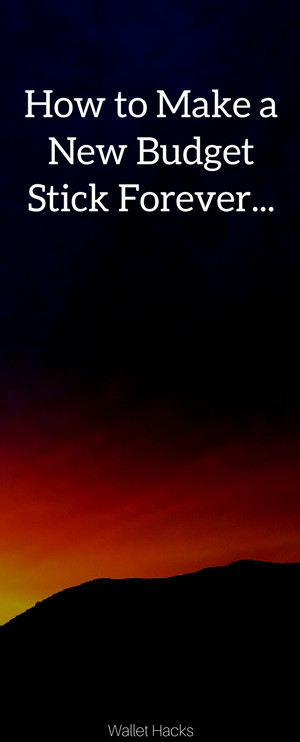We all know that budgeting is one of the best ways to find savings. Anything that gets measured can also be improved.

That budget taught me a lot about how I spent my money and, in turn, told me where I could squeeze if I wanted to save more. I was fortunate in that I was conditioned to live on a college student's meager budget even though I was now working a real job. My expenses stayed low, I was able to save a lot, and life was good.
What if you're not starting from a poor college kid's mindset? What if you already have a college kid's budget, it's been a budget you've been living with for years, and now have grand plans to try to make a shift to a budget that follows better money ratios?
What if you want to develop what some call a “rich budget?” What if you want to save 30% of your income but you're only saving 5%? Or 10%?
It's still possible but change is hard. You won't be able to sustain cutting everything you need to for savings to jump from 5-10% (or less) to 30%.
What you need is to make a transition budget. Like any habit, and spending is a habit, your best chance at success is if you shift slowly and over a longer period of time. Sudden shifts rarely work.
What is a Transition Budget?
It's a budget that recognizes you need to shift your spending over a period of months. Instead of making one target future budget, you make six.
It's like those smoking cessation programs where the amount of nicotine in each cigarette or patch gets lower and lower. You can't go from two packs a day to zero and expect to succeed. The same goes for your spending.
Here's a basic one I created in Google Docs. To play with it, Click on File -> Download As… to save a local copy and mess with it.
The basic idea is that we transition your current budget to your ideal budget over a span of six months. It's not one budget, it's six.
The math is simple. We take your goal, subtract your today, and spread the change over six months. Easy peasy lemon squeezy.
You can add periods to transition slower, remove periods to transition faster, add columns for additional expenses, whatever you want.
What about Fixed vs. Variable Expenses?
There is one other point in the budget.
There are two types of expenses in your budget – fixed and variable (Column R). Fixed expenses are items like housing (mortgage or rent), loan payments (car, student loans), and subscription services (cable internet, gym). It may be discretionary and it's not an expense you can easily adjust today just because you felt like it.
Variable expense are everything else, like groceries, eating out, etc. To a certain extent, you can adjust unilaterally. Want to spend less on dining out? Stop going out! You can't really do that with rent. 🙂
We make this distinction and leave fixed rows alone for our transition budget.
Gradual Shift in Flexible Categories
In the more flexible variable categories, you can make changes almost immediately. You aren't contractually bound to spending $500 a month in restaurants or bars. You aren't required to spend $250 on entertainment.
In these categories, you may not be able to go from spending $600 a month to $300 in a single month… but you probably can go from $600 to $550. Then cut another $50 the following month.
With these smaller changes, you ease into the new budget. $50 probably represents a night of going out. Instead of going out 12 nights, you go out 11. You skip that one night you otherwise would've gone out – that's totally doable.
How likely are you to cut out half of your nights out in one cut? Not likely!
That's what the transition budget enables you to do … it helps you eat that elephant one bite at a time.
Radical Shift in Inflexible Categories
About those fixed, or inflexible, categories — those still require attention. Any gains you have there can be put towards other categories.
You should be re-negotiating any subscription service every time the contract expires. Whether it's your cell phone or cable & internet, you owe it to yourself to get the best deal and cut as much as you can. You can use our guide on how to negotiate your cable bill as a guide towards negotiating anything.
Play with the fixed expenses on your target budget to see what a cut there could mean for your finances.
You can have an ideal budget. You can't have it next month, especially if your current budget is very far away from your ideal, but you certainly could adjust it over a period of 6-12 months. Increasing your savings is important because you can become a millionaire through saving alone.
Finally, while this focuses on the expense side of the financial equation, don't forget about the income side. You can and should do both simultaneously. Look for ways to make extra money or increase your salary because those can have a bigger impact on your budget than adjusting your expenses (even if you put your savings into passive income sources).




Miss Mazuma says
This is a great idea for those who are wondering how to get from point A to point B. Many of us talk about upping your retirement contributions by 1 or 2% a month so it doesn’t feel like a huge leap to go to 12% overnight – this post is quite similar but in regards to spending less slowly instead of whacking your spending in half overnight. Like a diet, if you go to extreme to fast you are doomed to rebound. This is a much gentler approach to get you where you want to be. 🙂
Gary @ Super Saving Tips says
Using transition budgets is a great way to set yourself up for success. You just have to make sure your goals are reasonable to accomplish within the timeframe you set up. Otherwise, you may find yourself failing the first month and giving up too quickly.
Xyz from Our Financial Path. says
Totally agree! The biggest obstacle to any budget is to stop following it. Making it simple really helps.
Having a transition can “ease the pain” a bit so you are more likely to stick with it.
Kurt says
For any big change, some kind of transition I think helps most people. Going ‘cold turkey’ may actually cut the odds of long-term success for some people, I think. Good advice!
Centsai says
A transition budget is a great idea! This article was very insightful and helpful! Happy holidays and a happy new year from the Centsai team!
Latoya |Femme Frugality says
This does sound interesting, i’m going to have to play around with your budget. Totally makes sense to ease into a new adjustment rather than just throwing yourself into something you’re not used to.